|
|
 |
|
Calanoida ( Order ) |
|
|
|
Clausocalanoidea ( Superfamily ) |
|
|
|
Clausocalanidae ( Family ) |
|
|
|
Pseudocalanus ( Genus ) |
|
|
| |
Pseudocalanus newmani Frost, 1989 (F,M) | |
| | | | | | | Syn.: | Pseudocalanus minutus Mori,1937 (1964) (p.36, Pl.15: figs.F,M: as elongatus);
P. elongatus Marukawa, 1908; ? Tanaka, 1956 c (p.384); Geletin, 1977 (p.82, figs.M);
Pseudocalanus sp. McLaren, 1965 (part.); ? Landry, 1983 (p.614, embryonic development); Ohman, 1985 (p.15, resource supply); 1986 (p.673, impact of predators);
? P. minutus elongatus: Vaupel-Klein, 1970 (p.8) | | | | Ref.: | | | Frost, 1989 (p.543, figs.F,M); Sévigny & al., 1989 (p.321 & suiv.: genetic); Chihara & Murano, 1997 (p.778, Pl.95: F,M); Bucklin & al., 1998 (p.97, Biomol.); Bucklin & al., 1999 (p.239, molecular systematic; Braga & al., 1999 (p.79, 84, tab.1, Rem.: Biol. mol.); Samatov, 2001 (p.259, fig. F,M: morphometric characters, Rem.); Bucklin & al., 2003 (p.335, tab. 2, fig.3, Biomol.); G. Harding, 2004 (p.48, Rem.); Aarkke & al., 2011 (p.1487, Table III, fig.2, genetic analysis); Questel & al., 2016 (p.610, Fig.3, genetic analyses, Table IV, VII, VIII) | 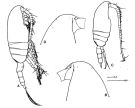 issued from : Frost B.W. in Can. J. Zool., 1989, 67. [Fig.20,p.544]. Female: A, habitus (lateral view); B, anterior portion of cephalosome (lateral view from left side). Male: C, habitus (lateral view); D, anterior portion of cephalosome (lateral view from right side). All scale bars = 0.1 mm.
|
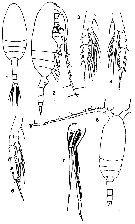 issued from : T. Mori in The pelagic Copepoda from the neighbouring waters of Japan, 1937 (1964). [Pl.15, Figs.1-7]. As Pseudocalanus elongatus. Female: 1, habitus (dorsal); 2, idem (lateral); 3, P2; 4, P3; 6, P4. Male: 5,habitus (dorsal); 7, P5.
|
 Issued from : A.D. Samatov in Biologiya Morya, Vladivostok, 2001, 27 (4). [p.262, Tableau 2 and 3]. Female and Male (from Avachinskaya Bay): Morphometric measures. TL = total length; PL : UL = cephalothoracic length: urosomal length; UIIIL : UIIIW = ratio (length : width of urosomal segment 3); CRL : UIIIW = ratio caudal ramus length : width urosomal segment 3; CL : UIII = ratio cephalothoracic length : urosomal segment 3 length; CRL : CRW = ratio caudal ramus length : width; A1 (8-12): A1 (20-21) = ratio length between segments ( 8-12) and (20-21).
See in Pseudocalanus minutus: same table 2 and 3: * = mean; ** = extent sizes; *** = standard deviation.
|
 Issued from : A.D. Samatov in Biologiya Morya, Vladivostok, 2001, 27 (4). [p.264, Fig.2]. Female (from Avachinskaya Bay): 1-2, habitus ( ventral and lateral, respectively); 3, cephalosome (lateral); 4, lasst thoracic segments and uosome (lateral). Male (from Avachinskaya Bay): 5, habitus (lateral); 6, A1; 7, P5; 8, coxo and basis of P4. Note the characteristic lateral ending of the tergite of the thoracic segments. Compare with P. minutus and P. acuspes.
| | | | | Compl. Ref.: | | | McLaren & al., 1989 (p.559, development vs. temperature); McLaren & al., 1989 (p.560, life history, annual production); Ohman, 1990 (p.257, figs., vertical migration vs predator); Hirakawa & al., 1990 (tab.3); Tsuda & Nemoto, 1990 (p.83, diet vs. fecal pellet size); Shih & Marhue, 1991 (tab.2, 3); Frost & Bollens, 1992 (p.1137, vertical migration vs predator); Tsuda, 1994 (p.81, starvation tolerance); Klein Breteler & al., 1994 (p.1039, fig.4, 6, 7, Table 1, Rem.: p.1053, stage frequency data); Aksnes & Ohman, 1996 (p.1461, mortality modelling): Ohman & Wood, 1996, p.126, mortality estimation); Yamaguchi & Shiga, 1997 (p.11); Mauchline, 1998 (tab.15, 24, 25, 45, 48, 58); Ban & al., 1998 (p.42, abundance vs. phytoplankton bloom); Tsuda & al., 1998 (p.1944, copepod gut content vs. predator); Dolganova & al., 1999 (p.13, tab.1); Logerwell & Ohman, 1999 (p.428, tab.1); Ban & al., 2000 (p.907); Yamaguchi & al., 2002 (p.1007, tab.1); Zuenko & Nadtochii, 2004 (p.526, tab.1, fig.8); Choi & al., 2005 (p.710: Tab.III); Manning & Bucklin, 2005 (p.233, Table 1, figs.5, 12, 13); Pierson & al., 2005 (p.349, vertical distribution vs Chl a concentration); Bragina, 2006 (pers. comm.); Liu & Hopcroft, 2008 (p.928: Table II); Takahashi & al., 2008 (p.222, Table 2, grazing impact); Ohtsuka & al., 2008 (p.115, Table 5); Galbraith, 2009 (pers. comm.); Chiba & al., 2009 (p.1846, Table 1, occurrence vs temperature change); Hopcroft & al., 2009 (p.9, Table 3); , Kosobokova & Hopcroft, 2010 (p.96, Table 1); Homma & Yamaguchi, 2010 (p.965, Table 2); Hopcroft & al., 2010 (p.27, Table 2); Ho^croft & Kosobokova, 2010 (p.49, figs.2, 3, 6, 7, 8, Table 1, 2, Rem.: egg production); Kosobokova & al., 2011 (p.29, Table 2, 3, Rem.: Canada Basin); Pomerleau & al., 2011 (p.1779, Table III); Homma & al., 2011 (p.29, Table 2, 3, 4, abundance, feeding pattern: suspension feeders); Matsuno & al., 2011 (p.1349, Table 1, abundance vs years); Matsuno & al., 2012 (Table 1, 2, fig.6); DiBacco & al., 2012 (p.483, Table S1, ballast water transport); Volkov, 2012 (p.474, Table 6, fig. 6, 11, abundance, distribution, interannual variation); Jang M.-C & al., 2012 (p.37, abundance and seasonal distribution); Gusmao & al., 2013 (p.279, Table 4, sex ratio); Barton & al., 2013 (p.522, Table 1: metabolism, population dynamic, feeding mode, biogeo); Questel & al., 2013 (p.23, Table 3, interannual abundance & biomass, 2008-2010); Ohtsuka & Nishida, 2017 (p.565, 578, Table 22.1). | | | | NZ: | 5 | | |
|
Distribution map of Pseudocalanus newmani by geographical zones
|
| | | 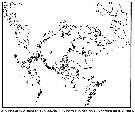 issued from : B.W. Frost in Can. J. Zool., 1989, 67. [p.529, Fig.3]. issued from : B.W. Frost in Can. J. Zool., 1989, 67. [p.529, Fig.3].
Geographical distribution of Pseudocalanus spp. |
 issued from : I.A. McLaren, M.J. Tremblay, C.J. Corkett & J.C. Roff in Can. J. Fish. Aquat. Sci., 1989, 46. [p.571, Fig.10]. issued from : I.A. McLaren, M.J. Tremblay, C.J. Corkett & J.C. Roff in Can. J. Fish. Aquat. Sci., 1989, 46. [p.571, Fig.10].
Annual cycle of Pseudocalanus newmani on Emerald Bank (43°30'N, 63°00'W), 1979-80.
Successive generations labelled Go, etc. For convenience, Nov. 1979 sample placed at end (after 1980). Upper panel: abundances as proportions of stages (AD: adults; males clear section of adult bar). Lower panel: size-frequencies of adult females as proportions.
The samples were obtained by vertical hauls from near bottom (usually 25 m) by Hensen-type nets (one of 0.250 mm mesh and the other of 0.064 mm mesh). |
 Issued from : H. Bi, K.A. Rose & M.C. Benfield in Mar. Ecol. Prog. Ser., 2011, 427. [p.157, Table 5]. Issued from : H. Bi, K.A. Rose & M.C. Benfield in Mar. Ecol. Prog. Ser., 2011, 427. [p.157, Table 5].
Instantaneous mortality rates (individuals per day) from litterature. |
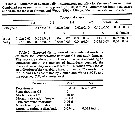 Issued from : D.L. Aksnes & M.D. Ohman inLimnol. Oceanogr., 1996, 41 (7).A vertical life table approach to zooplankton mortality. Example for Pseudocalanus newmani (from Dabob Bay, near Seattle, USA). Issued from : D.L. Aksnes & M.D. Ohman inLimnol. Oceanogr., 1996, 41 (7).A vertical life table approach to zooplankton mortality. Example for Pseudocalanus newmani (from Dabob Bay, near Seattle, USA). |
 Issued from : D.L. Aksnes & M.D. Ohman inLimnol. Oceanogr., 1996, 41 (7). [p.1468, Fig.4]. Comparisons of mortality estimates (per day) for Pseudocalanus newmani (from Dabob Bay) obtained by the vertical and horizontal approaches. Issued from : D.L. Aksnes & M.D. Ohman inLimnol. Oceanogr., 1996, 41 (7). [p.1468, Fig.4]. Comparisons of mortality estimates (per day) for Pseudocalanus newmani (from Dabob Bay) obtained by the vertical and horizontal approaches.
Nota: Mortality is commonly estimated from time series of abundances of the different stages of the species (horizontal live table approach) with the assumption that transport processes are of minor influence. The equations appropriate for analysis of stage distributions in samples at a single time (vertical life table approach) that, in certain circonstances, facilitate mortality estimation without requiring time series abundances. A primary assumption is that dayly recruitment to a particular stage should not be characterized by a strong upward or downward trend.
After comparisons of the two approaches, the conclusion is that the vertical approach may provide mortality estimates under conditions in which horizontal techniques are inappropriate. In contrast to estimates obtained with horizontal techniques, vertical estimates represent snapshot of the population. |
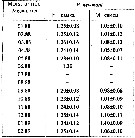 Issued from : A.D. Samatov in Biologiya Morya, Vladivostok, 2001, 27 (4). [p.263, Table 4]. Issued from : A.D. Samatov in Biologiya Morya, Vladivostok, 2001, 27 (4). [p.263, Table 4].
Seasonal total length in female (F) and male (M) in Avachinskaya Bay (SE Kamchatka : ± 53°00' N, 158°30' E). |
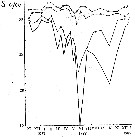 Issued from : A.D. Samatov & I.N. Samatova in Biologiya Morya, Vladivostok, 1996, 22 (1). [p.25, Fig.5]. Issued from : A.D. Samatov & I.N. Samatova in Biologiya Morya, Vladivostok, 1996, 22 (1). [p.25, Fig.5].
Seasonal variation of the salinity (per 1000) in Avachinskaya Bay) during November 1987 to January 1989 .
Seasonal variation of the salinity (per 1000).
1- surface mean; 2- 10 m depth; 3- in the bottom; 4- in surface at the station 2. (western Bay). |
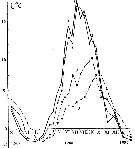 Issued from : A.D. Samatov & I.N. Samatova in Biologiya Morya, Vladivostok, 1996, 22 (1). [p.25, Fig.5]. Issued from : A.D. Samatov & I.N. Samatova in Biologiya Morya, Vladivostok, 1996, 22 (1). [p.25, Fig.5].
Seasonal variation of the temperature (t°C) in Avachinskaya Bay) during November 1987 to January 1989.
1- surface mean; 2- 10 m depth; 3- in the bottom; 4- in surface at the station 2. (western Bay). |
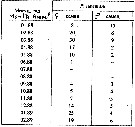 Issued from : A.D. Samatov in Biologiya Morya, Vladivostok, 2001, 27 (4). [p.260, Table 1]. Issued from : A.D. Samatov in Biologiya Morya, Vladivostok, 2001, 27 (4). [p.260, Table 1].
Seasonal abundance in female and male (by m3) in Avachinskaya Bay (SE Kamchatka : ± 53°00' N, 158°30' E) from January 1988 ton February 1989.
Compare with P. minutus and P. acuspes. |
| | | | Loc: | | | Delaware, Massachusetts Bay, G. of Maine, Georges Bank, Nova Scotia, Newfoundland, Hudson Bay , Arct. (Beaufort Sea, Chukchi Sea, off NW Alaska, Canada Basin), Bering Sea, SE Kamchatka, S Aleutian Basin, S Aleutian Is., Japan Sea, Korea Strait, Japan, Akkeshi Bay Ishikari Bay, , Otsuchi Bay, Hokkaido, Oyashio region, SW Hokkaido, Funka Bay, Station Knot, Aleutian Basin, ? Station “P” (in Vaupel-Klein, 1970), Washington (Dabob Bay, Friday Harbor), British Columbia | | | | N: | 55 | | | | Lg.: | | | (122) F: 1,53-0,94; M: 1,17-0,84; ? (205) F: 1,3-1; (1222) F: 1,0-1,50; M: 0,90-1,20; {F: 0,94-1,53; M: 0,84-1,20} | | | | Rem.: | Characteristics according to Frost (1989): See limits of lenght measurements in the figure of the genus Pseudocalanus
Female: Frontal part in lateral view rounded; mediodorsal surface of U1-U3 without sensillum; mediodorsal surface of U1 and U3 without integumental pore; ratio lenghts Prosome:Urosome = 2.18 (1.97-2.32)
Male: ratio of lenghts B1:B2 of P4 < 1.5; ratio of lenghts of segments of A1 (8-12):(20-21) <2.0; mediodorsal surfaces of U2-U4 without sensillum; ratio of lenghts Cephalosome:U2 = 5,45 (4,93-6,33)
U: urosome with furca included.
For Kosobokova & Hopcroft (2010) this species is a Pacific expatriate.
Ohrsuka & Nishida (2017, p.578) consider this species as a cold-water species on the japanese coasts infuenced by Oyashio waters.
The feeding mode after Barton & al. (2013, Table 1) is 'feeding current' (hovering) (See definition in Rem. Centropages typicus). | | | Last update : 26/10/2020 | |
|
|
 Any use of this site for a publication will be mentioned with the following reference : Any use of this site for a publication will be mentioned with the following reference :
Razouls C., Desreumaux N., Kouwenberg J. and de Bovée F., 2005-2025. - Biodiversity of Marine Planktonic Copepods (morphology, geographical distribution and biological data). Sorbonne University, CNRS. Available at http://copepodes.obs-banyuls.fr/en [Accessed October 22, 2025] © copyright 2005-2025 Sorbonne University, CNRS
|
|
 |
 |














